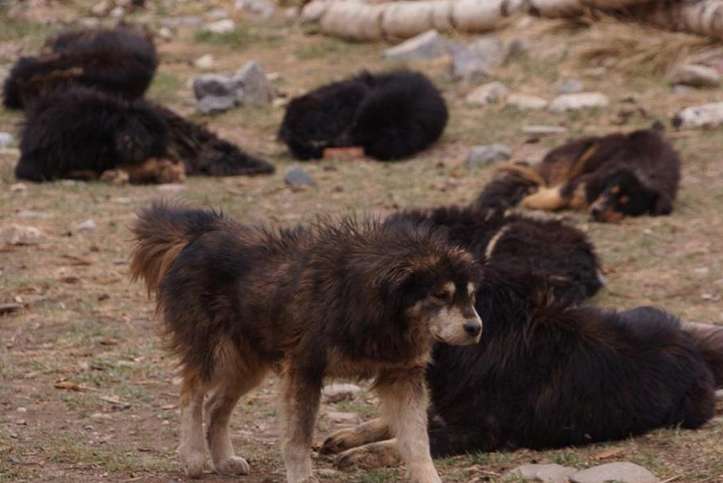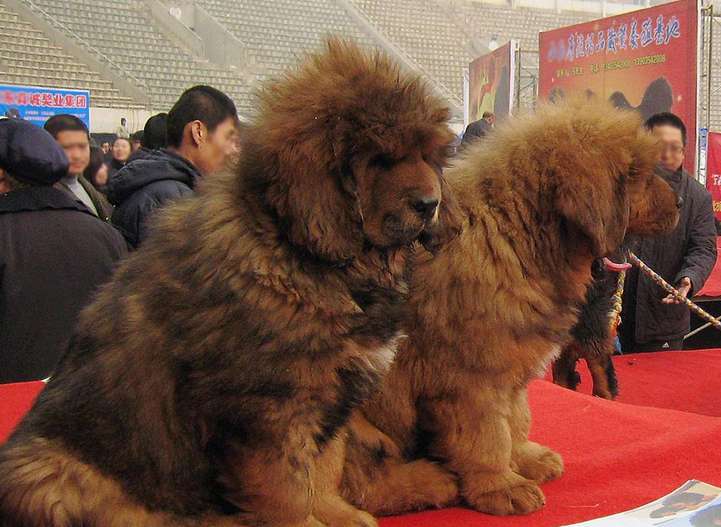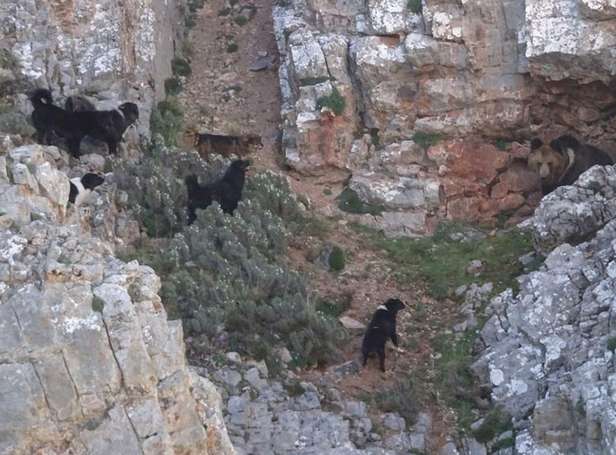Speaking of fierce dogs like the Tibetan Mastiff, many people may know that this is a dog breed native to the Qinghai-Tibet Plateau. It is famous for its ferocious personality and huge size. An adult Tibetan Mastiff can even reach more than 70 kilograms.
Originally, Tibetan Mastiffs were only popular among niche circles such as herdsmen. Later, due to some opportunities, they became widely known to the Chinese people. The value of Tibetan Mastiffs once skyrocketed. Buying a Tibetan Mastiff can cost as little as hundreds of thousands, as much as millions, or even tens of millions, making it a veritable ten-million-dollar dog.

Later, as the Tibetan Mastiff craze subsided, a large number of Tibetan Mastiffs had no market. Abandoned in the wild, he became a stray dog on the plateau. They gathered together, and under the leadership of the Mastiff King, they fought with the snow leopards and competed with the wolves for food, becoming the overlords on the plateau.
Tibetan Mastiff fever is on the rise and has been sold for tens of millions at auction
In the early days, there was no breed of Tibetan Mastiff on the Qinghai-Tibet Plateau. About 24,000 years ago, some low-altitude dog breeds followed Early immigrants came to live on the Qinghai-Tibet Plateau.
During the long process of living on the plateau, some dogs still hybridized with the local ancient Tibetan wolves, so that the offspring dogs carried half of the genes from Tibetan wolves, including genes that allowed them to adapt to plateau life. The key gene, which scientists call "EPAS1", is also found in some high-altitude species.
Under the influence of this gene, future generations of dogs gain the ability to regulate hemoglobin production, allowing them to live on plateaus with thin oxygen for a long time. In addition, during the long process of species evolution, they have also undergone some adaptive changes, such as thicker hair, thicker fat, larger body size, etc., thus the Tibetan Mastiff dog breed was formed.
Although Tibetan Mastiffs are native to the Qinghai-Tibet Plateau, they first became popular in Europe and the United States. Around the 1980s, this huge, thick-haired, fierce dog that looked like a little lion was sought after by a large number of foreigners. The Tibetan Mastiff was also known as the "Oriental Divine Dog."

After the 1990s, this "Tibetan Mastiff craze" spread back to China, and some people who sensed business opportunities quickly added fuel to the flames and bred Tibetan Mastiffs in large quantities, attracting everyone to flock to them, and the value of Tibetan Mastiffs also increased. It is common for some good-looking Tibetan mastiffs to be worth millions. In 2011, a purebred Tibetan mastiff was even sold for 10 million yuan.
The bubble burst, leaving groups of Tibetan Mastiffs with no sales
In fact, it is foreseeable that the Tibetan Mastiff economic bubble bursts, because the Tibetan Mastiff itself is a plateau dog breed, and their body structure is doomed. It is suitable for living in low-altitude areas, and its ferocious character is not suitable for ordinary people to keep.
So as more and more incidents of Tibetan mastiffs hurting people appeared, and people's interest faded, consumption gradually returned to rationality, and the bubble finally burst in 2013.
Consumers’ desire to buy disappeared, market demand dropped sharply, and the lag in market regulation caught a large number of mastiff owners by surprise. A large number of Tibetan mastiffs on hand suddenly lost their market, even some in very good condition. The Tibetan Mastiff cannot find a buyer.
At that time, the owners of the mastiff farms still had a glimmer of hope, hoping that one day the market would pick up and their Tibetan mastiffs could be sold at a good price. Unfortunately, things went against expectations, and the huge daily food expenses became the last straw for the mastiff owner.
Unable to bear it anymore, people abandoned a large number of Tibetan Mastiffs in the wild, leaving only some excellent-looking individuals for the chance to sell them at a good price in the future. However, more Tibetan mastiffs have become homeless stray dogs, wandering on the Qinghai-Tibet Plateau all day long, surviving by picking up garbage and feeding people. The famous dog worth tens of millions has now become a homeless stray dog.

Tibetan Mastiffs transform into an army to fight brown bears, fight snow leopards, and rob wolves for food. Eating
At the beginning, these Tibetan mastiffs were not large-scale, and most of them gathered near the villages all day long, picking up garbage or secretly preying on poultry to make a living.
As time went by, dogs naturally lived in groups, so a large number of wandering Tibetan mastiffs gathered together and became a huge herd of predators on the plateau.
The domestication process from wild animals to poultry and livestock is quite long, but the process from domestic animals to wild beasts again is very short. For example, the wild dogs in Australia are a living example. As the wildness of a large number of stray Tibetan mastiffs gradually recovers, they begin to go out into the wild and try to hunt wild animals.
Although after the "Tibetan Mastiff fever" subsided, many people began to belittle the Tibetan Mastiff, but notThere is no denying that this breed of dog is very large and has a very ferocious personality, not to mention being very gregarious.
It is conceivable that ordinary wild animals cannot be the opponents of Tibetan mastiff groups. Even Tibetan wolves, snow leopards, Tibetan bears and other famous beasts on the Qinghai-Tibet Plateau are vulnerable to the huge wandering mastiff groups. You have to go with your tail between your legs. So soon, the wandering mastiff group became the largest beast force on the Qinghai-Tibet Plateau.
Perhaps a Tibetan Mastiff may not be a match for snow leopards and Tibetan brown bears when fighting alone, but Tibetan Mastiffs never talk about martial arts with them one-on-one. Some of them just rush up in a group and beat you one by one.
In 2016, a scholar from Beijing took a series of photos of Tibetan Mastiffs claiming dominance on the plateau.
The stray mastiffs, led by the Mastiff King, chased the blue sheep, fought off the snow leopards, competed with Tibetan wolves for food, and forced the brown bears to retreat. These deeds one by one all showed that the stray Tibetan Mastiffs The ecological status of the Tibetan Plateau in this ecosystem.
A group composed of a large number of wandering Tibetan mastiffs has strength beyond that of wolves. Their appearance has reshuffled the situation of beasts on the plateau, and the status of the snow leopard as the king of the plateau has become precarious.
Of course, the emergence of stray Tibetan mastiffs cannot be entirely blamed on the mastiff farm. In addition, a large number of stray Tibetan mastiffs come from herdsmen families.
The herdsmen transitioned from the original nomadic life to settling in cities, and it seemed inappropriate to bring the Tibetan Mastiff with them, so those who gave it away were given away, those who were taken away were taken away, and the remaining ones became Wandering Tibetan Mastiff. A large number of stray Tibetan mastiffs not only affect people's lives, but also have a huge impact on the local ecosystem.